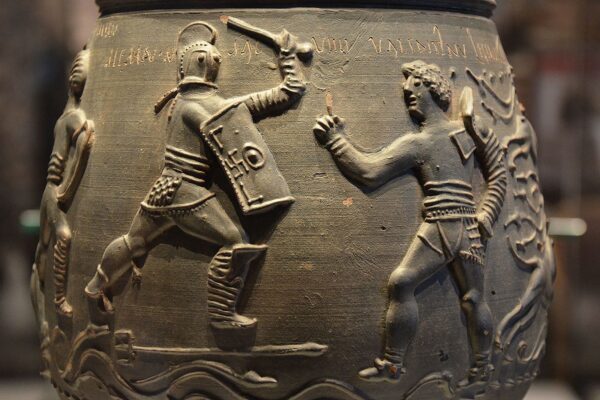
The crowds roaring. The athletes preparing for battle, strapping on their helmets and armor. Today we might be talking about a football game, but for ancient Romans, it was the gladiators who filled stadiums and practiced their crafts in front of thousands of adoring fans cheering them on.
When we think of the great gladiatorial contests, we typically think of the Roman Coliseum, but new research shows that such contests happened as far away from Rome as Britain.
The best piece of evidence might be a piece of ancient sports memorabilia that perhaps wasn’t too different from the jerseys and playing cards that so many sports fans collect today.
The Guardian writes, “Crucial evidence has been discovered within a spectacular vase – decorated with a depiction of a gladiatorial combat – which was unearthed from a Roman grave in Colchester in 1853.
New tests prove the Colchester Vase was made of local clay around AD 160-200 and that an inscription bearing the names of two featured gladiators was cut into the clay before firing, rather than afterwards, as previously assumed. It was therefore an intrinsic part of the vessel’s original design rather than a later addition to a generic arena representation.
Frank Hargrave, director of Colchester and Ipswich Museums (CIMS), which owns the vase, told the Observer the research has led to “startling new conclusions”, showing its true significance in recording a real spectacle in Colchester, known to the Romans as Camulodunum.
“It’s the only evidence of a Roman arena gladiator combat actually being staged in Britain,” he said. “There are no written descriptions. The vase is such high quality that there’s been a bit of snobbery, an assumption that it couldn’t possibly have come from Britain, whereas all the analysis has now put that to bed.”
Another outlet explained that the “vase was discovered in a Roman-era grave in West Lodge, Colchester, in 1853. Its format suggests it was more likely a drinking vessel rather than a pitcher or vase, but whatever its original usage, its final use was a cinerary urn. The vessel is nine inches high and is decorated on the outside with three scenes. There are two armed men facing off against each other, two men, one wielding a whip, the other a club, baiting a bear and lastly a hunting dog chasing two stags and a hare. These scenes represent the three types of encounters staged at the arena: men fighting other men, men fighting animals and animals fighting other animals. It is one of the most intricately decorated Roman-era pots ever found in Britain.
The armed men fighting each other can be identified as gladiators by their armature. The one with a short sword (gladius), large rectangular shield (scutus), greaves and a large helmet covering his entire face was a secutor. His opponent, wearing the tall shoulder guard (galerus), arm guard (manica) and loin cloth, is a retiarius or “net fighter.” His trident is on the ground under the secutor’s feet and his finger is raised in the “ad digitum” gesture to acknowledge defeat and request that the munerarius (game director) grant him “missio” (reprieve).
Four names are incised on the vase: Memnon over the secutor, Valentinus over the retiarius, Secundus and Mario above the bear baiter with the whip. Next to Memnon’s name are the initials SAC and the numeral VIIII, recording that he fought nine times and lived. Next to Valentinus’ name is inscribed LEGIONIS XXX, indicating the retiarius was a soldier in the 30th Legion. This legion was never stationed in Britain.
The uniqueness of the decoration and the reference to a legion that never stepped foot in Britain has spurred debate as to its origin. The clay it was made from was local, but the inscription seemed to point to a foreign hand.”
Now that mystery might be solved. The BBC noted, “Glynn Davis, a senior curator of Colchester and Ipswich Museums, told The Observer that the vase may have belonged to a sponsor of the gladiatorial fight depicted.
The item is due to go on display at Colchester Castle from 15 July, along with other significant Roman finds.
Colchester is one of England’s most historic cities, having become the capital of Roman Britain soon after the conquest of AD 43, and known as Camulodunum.”
[Read More: Woman Makes Gesture To Honor A Queen And She’s Handsomely Rewarded]










Maybe gladiator games were played all over Roman Europe then